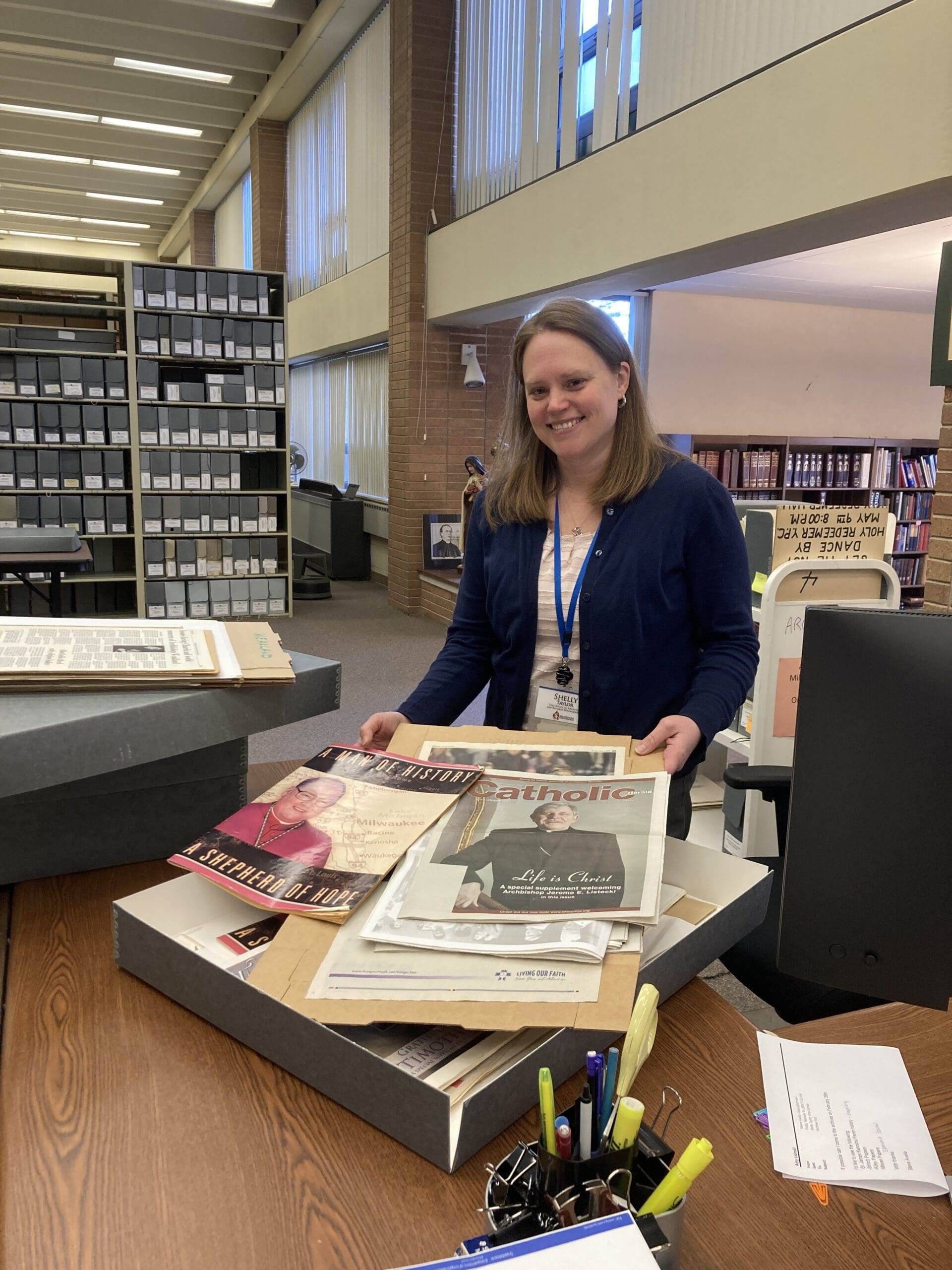
Shelly Taylor, Director of the Archdiocese of Milwaukee Office of Archives and Records Management at the Mary Mother of the Church Pastoral Center in St. Francis, displays some special editions of the Catholic Herald from the archives’ holdings. (Photo by Kathleen McGillis Drayna)
When Milwaukee’s first Catholic leader, Archbishop John Martin Henni, communicated with people in the mid-1800s, he spoke to them directly or wrote letters, homilies or speeches.
You can find his documents — handwritten, primarily in German — on paper in the Archdiocese of Milwaukee Archives.
More than 175 years later, the archdiocese’s 11th archbishop, the Most Rev. Jerome Listecki, serves as our spiritual leader using many modern means.
In a typical week, he writes his personal Love One Another email letter that is sent to about 10,000 people, releases his encouraging The Good News short video and hosts the 30-minute Living Our Faith radio show.
In other examples that barely scratch the surface of his communications, Archbishop Listecki often also writes letters sent to all parishioners of the archdiocese, gives homilies, speaks at many events and is a rotating columnist for the Catholic Herald.
Thus, the archivist has a greater challenge to capture a history of Catholicism as it is lived in the Archdiocese of Milwaukee in this day and age.
On top of the varied means of communication, rapid changes in technology mean that even a letter created in Microsoft Word today likely will be incompatible with Word just a decade or two from now.
An effort to digitize important archdiocesan records and images has barely made a dent, but it is hoped this will ultimately make some first-hand records more widely available online.
“Our goal is not to digitize everything,” said Shelly Taylor, Director of the Archdiocese of Milwaukee Office of Archives and Records Management. The present archives collection occupies about 4,500 cubic feet. One cubic foot is about the size of the storage box known as a banker’s box. “We’re prioritizing what we do because not everything needs to be digitized.”
Taylor’s office collects, preserves, organizes and makes available for research many, many types of records.
There are five major areas of archive collections: corporate administrative documents going back to the founding of the archdiocese; historic records of Saint Francis de Sales Seminary; records of various Catholic entities, such as the Milwaukee Council of Catholic Women; records of Catholic individuals such as archbishops and bishops; and records of closed and merged parishes. Canon law calls for active parishes to keep their own archives.
Digitizing images began on a small-scale basis around 2006 with a scanner, with perhaps one or two records being scanned in order to email them to someone. Over time, the scanning process has become easier, and fees charged for this service has helped fund updates.
Digitizing photographs became an urgent need about 10 years ago, several years before the 175th anniversary of the archdiocese in 2018. Taylor and Associate Director Amy Lisinski knew access to many, many old photos would be needed for this yearlong celebration, and these records would need to be searchable.
This is best achieved with digital images of records that can include detailed metadata. Metadata is not the information contained within the image, but data about the image itself. It is key words tied to individual images regarding the who, what, when and where of whatever was in the picture, as well as a title, creator, publisher, format, identifier, source and “rights,” such as copyright information or permission needed.
However, it might take 10 to 15 minutes to create a high-quality scan of just one photo and add information about it in the metadata fields, Taylor said. While interns have been able to assist with this, an experienced person can do this much more quickly than an intern who does not have a lot of institutional knowledge of the archdiocese as part of their background.
Everything, starting with the name of the image, needs to be consistent with the names of other like records. For example, every record of a particular parish needs to express the name of the parish in exactly the same way in order for all to be consistently searchable. And every record related to a parish needs to include data in a like way so a search for information about parishes in general captures as much of it as possible.
The archivists dream of when some materials could be used more widely in Catholic school curriculum on state history in fourth grade and U.S. history in eighth grade.
Taylor noted that digitization is one small thing that is part of the archive’s responsibilities.
Taylor, who is part time, and Lisinski, who is full time, are the office’s only two employees. In addition to maintaining the archives, they answer questions for anyone who contacts the office. A recent day brought in requests regarding the history of the Saint Francis de Sales Seminary coat of arms, the St. Vincent de Paul Society here, class reunions and a parish certificate of occupancy.
Simple requests take just a few minutes to answer, while others may require a lot of research. The most common request is for sacramental records from one of the 100 merged or closed parishes. About 800 such requests came in last year from people requesting their own records, while another 400 were for records from prior to 1920 available for genealogy purposes.
